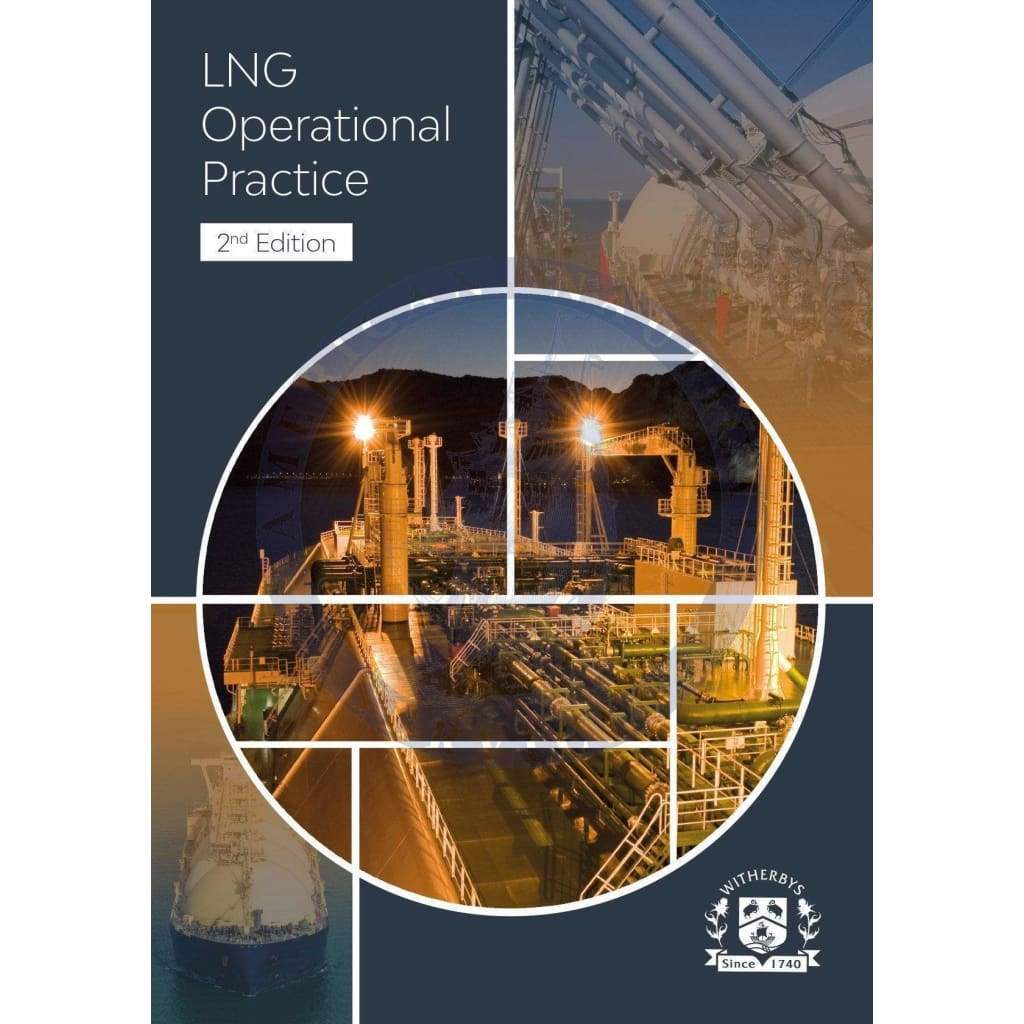Overview
This second edition is updated for 2020 to reflect the substantial changes and new designs in the technical and operational aspects of LNG shipping and the transportation of LNG by sea, since this book was first published in 2006. It is prepared as a practical handbook for the operation of LNG carriers.
This book is written for LNG Officers who require a better understanding of the processes involved in operating a modern LNG carrier. The book is laid out with clear diagrams, checklists, guidance and instructions for each of the operations undertaken at each stage of a typical trading cycle for an LNG carrier including: Post dry-dock, Drying of cargo tanks, inerting of cargo tanks, gassing-up the cargo tanks, initial cooldown of cargo tanks, cargo loading, laden voyage, cargo discharge, ballast voyage, ship to ship transfer and preparations for dry-dock including warming-up of cargo tanks, inerting of cargo tanks and aeration of cargo tanks.
Content
Preface
Acknowledgements
Section 1: General Information
1 Physical Properties, Composition and Characteristics of LNG
1.1 Overview
1.2 Flammability of LNG
1.3 Saturated Vapour Pressure (SVP)
1.4 Vapour Density
1.5 Safety Precautions in LNG Handling
2 Normal Trading Cycle of an LNGC
3 Cargo Containment Systems
3.1 Overview
3.2 Moss Rosenberg (Moss)
3.2.1 Leak detection
3.3 Mark III (GTT)
3.3.1 Membrane or primary barrier
3.3.2 Insulation and secondary barrier
3.3.3
Interbarrier and insulation space (IBS/IS) N2 pressurisation and control system
3.4 NO96 (GTT)
3.4.1
Primary insulation space (PIS) and secondary insulation space (SIS) N2 pressurisation and
control system
4 Cargo Handling Equipment
4.1 Cargo Pump
4.2 Spray/Stripping Pump
4.3 High Duty Compressor
4.4 Low Duty Compressor
4.5 Gas Heater
4.6 Vaporiser
4.7 Reliquefaction Plant
4.8 Gas Combustion Unit (GCU)
5 Auxiliary Equipment
5.1 The Cargo Valves Remote Control System
5.2 Ship/Shore Link and ESD System
5.3 N2 Generator
5.4 IG Plant
5.5 Custody Transfer and Measurement System (CTMS)
5.6 Cargo Tank Gauging System
5.6.1 Cargo tank float gauge
5.7 Gas Detection Equipment
5.8 Cofferdam Heating System
5.9 Vacuum Pumps
5.10 Tank Overflow Protection
Section 2: Post Dry-dock Operations
6 Operations Related to Auxiliary Systems
6.1 Moss Type LNG Carriers
6.1.1 Overview
6.1.2 Removing ambient humid air from the hold spaces
6.1.3 Drying and inerting of tank insulation and annular space
6.2 Membrane Type LNG Carriers (Mark III and NO96)
6.2.1 Overview
6.2.2
Removing ambient humid air from the insulation spaces of Mark III cargo containment system
6.2.3
Removing ambient humid air from the insulation spaces of NO96 cargo containment system
7 Cargo Tank Operations
7.1 Drying of Cargo Tanks
7.1.1 Overview
7.1.2 Preparation for drying
7.1.3 Operational description – cargo tanks drying
7.1.4 Further considerations
7.2 Inerting of Cargo Tanks
7.2.1 Overview
7.2.2 Preparation for inerting
7.2.3 Operational description – inerting cargo tanks prior to gassing-up
7.2.4 Further considerations
7.3 Gassing-up the Cargo Tanks
7.3.1 Overview
7.3.2 Preparation for gassing-up
7.3.3
Operational description – gassing-up the cargo tanks with LNG vapour and IG vented to
atmosphere
7.3.4 Operational description – gassing-up the cargo tanks with LNG vapour and IG returned to shore
7.3.5 Further considerations
7.4 Initial Cooldown of Cargo Tanks
7.4.1 Moss type LNGC
7.4.2 Membrane type LNGC
7.4.3 Operational description – cargo tanks cooldown
7.4.4 Further considerations
Section 3: In-service Operations
8 Loading Operations
8.1 Overview
8.2 Preparation for Loading
8.3 Pre-loading Operations
8.4 Cooldown for Loading
8.5 Ramp-up to Bulk Rate
8.6 Bulk Rate Loading
8.7 Ramp-down
8.8 Post-loading Operations
8.9 Departure from Load Port
9 Laden Voyage
9.1 Overview
9.2
Laden Voyage of LNG Carriers with Gas Burning Propulsion System
9.2.1 Steam plant
9.2.2 Engines and generators
9.2.3 Consideration for all gas burning systems
9.3
Laden Voyage of LNG Carriers with Reliquefication Plant
9.4 Further Considerations on Laden Voyage
10 Discharge Operations
10.1 Overview
10.2 Preparation for Discharge
10.3 Pre-discharge Operations
10.3.1 Operational description – MLAs and liquid header cooldown prior to discharging
10.4 Ramp-up to Bulk Rate
10.4.1 4-step ramp-up
10.4.2 8-step ramp-up
10.5 Operational description – bulk rate discharge
10.6 Ramp-down
10.6.1 Ramp-down ‘heel retained’
10.6.2 Operational description – ramp-down ‘heel out’ (cargo tank stripping)
10.7 Post-discharge Operations
10.8 Departure from Discharge Port
10.9 Further Considerations During Discharge
11 Ballast Voyage
11.1 Overview
11.2 Heel Management
11.2.1
Heel management of LNGCs with a gas burning propulsion system
11.2.2
Heel management of LNGCs with a reliquefaction plant
11.3 Further Considerations on Ballast Voyage
12 Ship to Ship Transfer Operations
12.1 Pre-arrival Stage
12.2 Approach and Mooring Stage
12.3 Cargo Transfer Stage
12.4 Post-transfer Procedure
Section 4: Pre Dry-dock Preparations
13 Cargo Tank Operations
13.1 Warming up Cargo Tanks
13.1.1 Overview
13.1.2 Preparation for warming up
13.1.3 Operational description – cargo tanks warming up
13.1.4 Further considerations
13.2 Inerting of Cargo Tanks
13.2.1 Overview
13.2.2 Preparation for inerting
13.2.3 Operational description – cargo tank inerting after warming up
13.2.4 Further considerations
13.3 Aeration of Cargo Tanks
13.3.1 Overview
13.3.2 Preparation for aeration
13.3.3 Operational description – cargo tank aeration
13.3.4 Further considerations
Glossary
Glossary
Details
Title: LNG Operational Practice. 2nd Edition
Number of Pages: 140
Product Code: WS1677K
ISBN: ISBN 13: 978-1-85609-871-7 (9781856098717), ISBN 10: 1-85609-871-0 (1856098710)
Published Date: January 2020
Binding Format: Paperback
Book Height: 300 mm
Book Width: 210 mm
Book Spine: 5 mm
Weight: 2.20 kg








